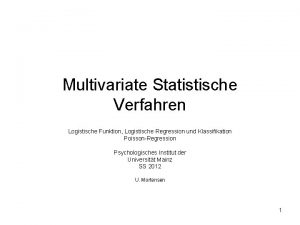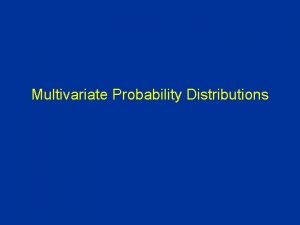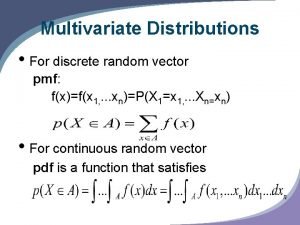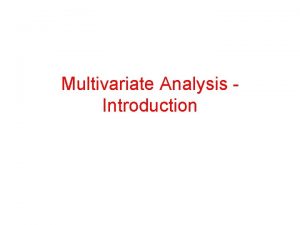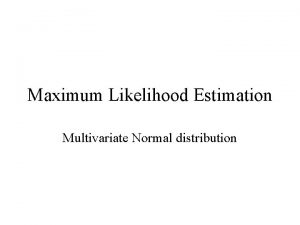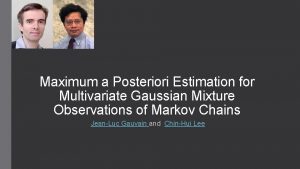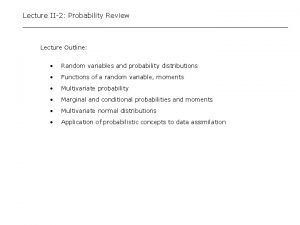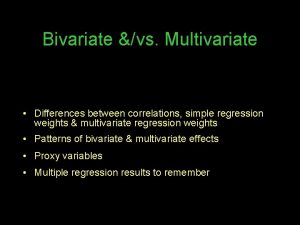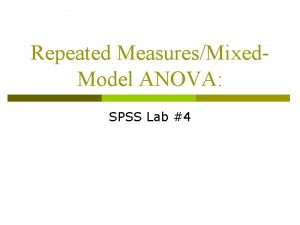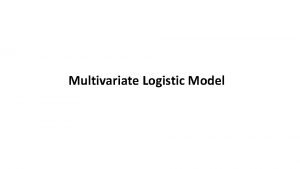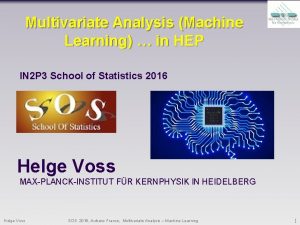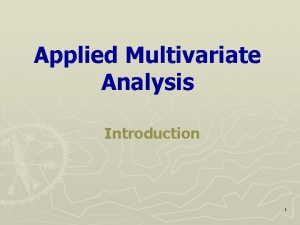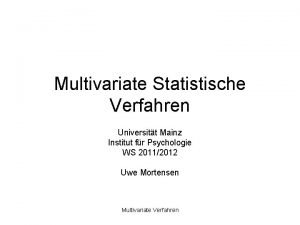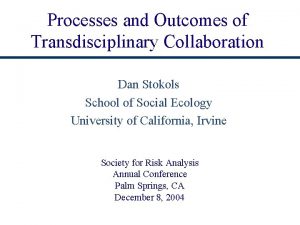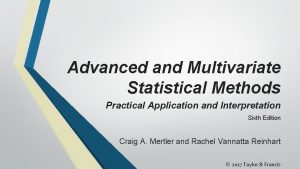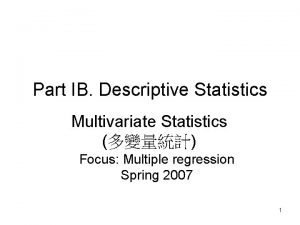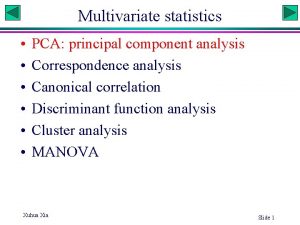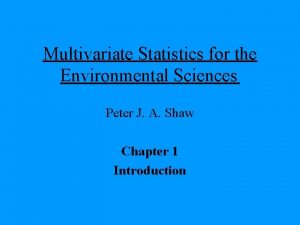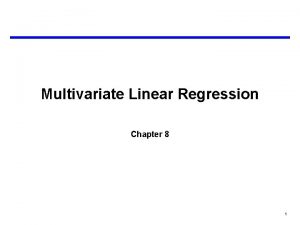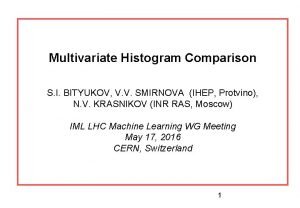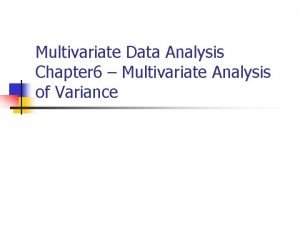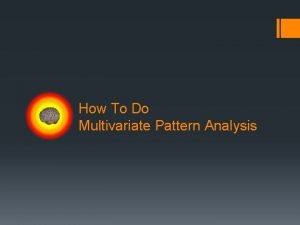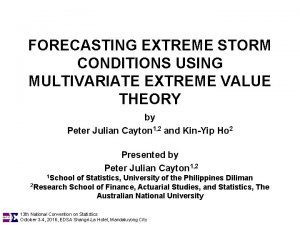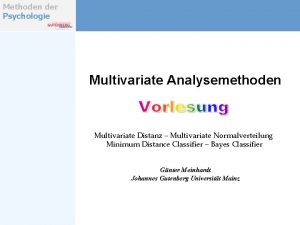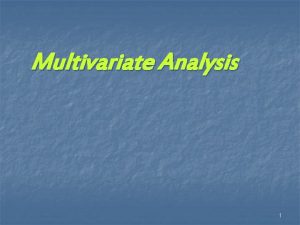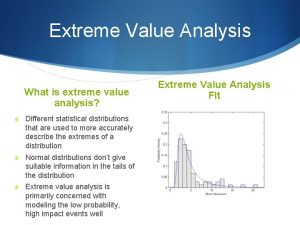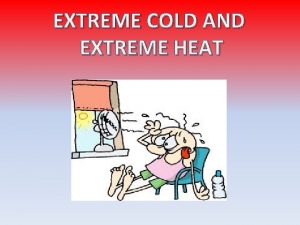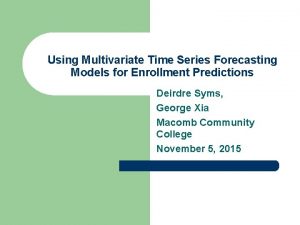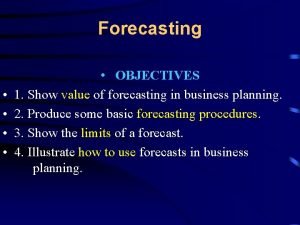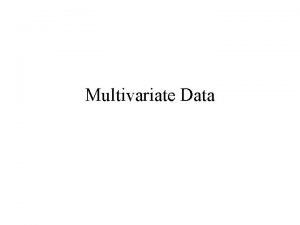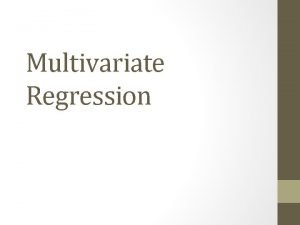FORECASTING EXTREME STORM CONDITIONS USING MULTIVARIATE EXTREME VALUE






























- Slides: 30

FORECASTING EXTREME STORM CONDITIONS USING MULTIVARIATE EXTREME VALUE THEORY by Peter Julian Cayton 1, 2 and Kin-Yip Ho 2 Presented by Peter Julian Cayton 1, 2 1 School of Statistics, University of the Philippines Diliman 2 Research School of Finance, Actuarial Studies, and Statistics, The Australian National University 13 th National Convention on Statistics October 3 -4, 2016, EDSA Shangri-La Hotel, Mandaluyong City

Flow of the Presentation 1. 2. 3. 4. Disaster Risk from Weather Extremes Multivariate Extreme Value Theory Methods Proposed Methodology Real Data Application: Philippine Area of Responsibility in the Western Pacific Basin 5. References 13 th National Convention on Statistics October 3 -4, 2016, EDSA Shangri-La Hotel, Mandaluyong City

Disaster Risk from Weather Extremes From the work of Helbing et al. (2006), disasters: Ø are seen as extreme events, and their occurrences are more frequent than expected if they are assumed to follow the normal distribution Ø can be a cause for or caused by a cascade of other disastersn (e. g. , dam overflows, floods, death, loss of livelihood, and homelessness). Disaster risk mitigation and management is an imperative for susceptible countries to prepare for such disasters. 13 th National Convention on Statistics October 3 -4, 2016, EDSA Shangri-La Hotel, Mandaluyong City

Disaster Risk from Weather Extremes With climate change, storm systems are becoming more frequent. In terms of economics, storms tends to have a negative effect on growth, with the agricultural sector most heavily affected (World Bank and United Nations 2010) 13 th National Convention on Statistics October 3 -4, 2016, EDSA Shangri-La Hotel, Mandaluyong City

Disaster Risk from Weather Extremes The number of storms entering the Philippine jurisdiction may not have significant trends, but their impact has been increasing in trend in terms of economic losses and damages. (Cinco et al. 2016) The proposed methodology is to be applied with Philippine typhoon data to gain understanding of the phenomenon for disaster risk management and climate change adaptation. 13 th National Convention on Statistics October 3 -4, 2016, EDSA Shangri-La Hotel, Mandaluyong City

Multivariate Extreme Value Theory Methods • 13 th National Convention on Statistics October 3 -4, 2016, EDSA Shangri-La Hotel, Mandaluyong City

Multivariate Extreme Value Theory Methods • 13 th National Convention on Statistics October 3 -4, 2016, EDSA Shangri-La Hotel, Mandaluyong City

Multivariate Extreme Value Theory Methods An example of a Pickands function 13 th National Convention on Statistics October 3 -4, 2016, EDSA Shangri-La Hotel, Mandaluyong City

Multivariate Extreme Value Theory Methods Measure of tail dependence based on the Pickands function: Three approaches to estimating the BEVD (Pickands 1981; Berlaint et al. , 2004; Stephenson 2002): 1. Nonparametric Approach 2. Semi-Parametric Approach, where G 1 and G 2 are estimated with the GEV distribution 3. Parametric Approach, where a copulas are used with G 1 and G 2 are estimated with the GEV distribution 13 th National Convention on Statistics October 3 -4, 2016, EDSA Shangri-La Hotel, Mandaluyong City

Multivariate Extreme Value Theory Methods • 13 th National Convention on Statistics October 3 -4, 2016, EDSA Shangri-La Hotel, Mandaluyong City

Multivariate Extreme Value Theory Methods • 13 th National Convention on Statistics October 3 -4, 2016, EDSA Shangri-La Hotel, Mandaluyong City

Multivariate Extreme Value Theory Methods Bootstrapping in multivariate extreme theory statistics: • a conditional approach to multivariate extreme values, where bootstrapping is part of an estimation procedure of parameters in the defined conditional extreme value model (Heffernan and Tawn 2004) • 2 bootstrapping the stable tail dependence function, which simplies to the Pickands dependence function for bivariate extreme value theory (Peng and Qi 2008) We use bootstrapping to augment the proposed methodology 13 th National Convention on Statistics October 3 -4, 2016, EDSA Shangri-La Hotel, Mandaluyong City

Proposed Methodology Storm-at-Risk Curves Ø An extension of the methodology of cumulative survival quantile curves with bootstrapped extreme value theory methods (Peng and Qi 2008; Heffernan and Tawn 2004) to provide confidence bands. Ø Two approaches, (1) nonparametric and (2) semiparametric methods, are proposed and their advantages and disadvantages are discussed. 13 th National Convention on Statistics October 3 -4, 2016, EDSA Shangri-La Hotel, Mandaluyong City

Proposed Methodology 13 th National Convention on Statistics October 3 -4, 2016, EDSA Shangri-La Hotel, Mandaluyong City

Proposed Methodology 13 th National Convention on Statistics October 3 -4, 2016, EDSA Shangri-La Hotel, Mandaluyong City

Real Data Application Philippine Area of Responsibility img url: https: //upload. wikimedia. org/wikipedia/commons/1/ 19/PAGASA AOR World Wind. png 13 th National Convention on Statistics October 3 -4, 2016, EDSA Shangri-La Hotel, Mandaluyong City

Real Data Application Storms in the Philippine Area of Responsibility • the data is from the International Best Track Archive for Climate Stewardship (IBTr. ACs) database (Knapp et al. 2010), with years spanning from 1881 to 2014. • the data for demonstration will be from 1977 to 2014, a period of 37 years • only TCs that enter the Philippine area of responsibility are used 13 th National Convention on Statistics October 3 -4, 2016, EDSA Shangri-La Hotel, Mandaluyong City

Real Data Application Storms in the Philippine Area of Responsibility • from each TC, two variables were gathered: (1) wind speed, and (2) barometric pressure measured every 6 hours • for practical purposes, the negative of barometric pressure is used. • componentwise maxima of wind speed and negative pressure are gathered from each TC. • only data with positive wind speed is used; TCs with zero wind speed are removed. • overall, 555 individual TCs were in the demonstration data 13 th National Convention on Statistics October 3 -4, 2016, EDSA Shangri-La Hotel, Mandaluyong City

Real Data Application The following outputs are displayed, for both nonparametric and semiparametric approaches: 1. the Pickands dependence function, with 95% confidence intervals 2. the estimated χ, with 95% confidence intervals 3. the estimated 5% storm-at-risk curve, with 95% confidence 4. the once-in-ten years (0. 667% ) storm-at-risk curve, with 95% confidence 5. the once-in-one-hundred years (0. 0667% ) storm-at-risk curve, with 95% confidence 13 th National Convention on Statistics October 3 -4, 2016, EDSA Shangri-La Hotel, Mandaluyong City

Real Data Application: Outputs 13 th National Convention on Statistics October 3 -4, 2016, EDSA Shangri-La Hotel, Mandaluyong City

Real Data Application: Outputs 13 th National Convention on Statistics October 3 -4, 2016, EDSA Shangri-La Hotel, Mandaluyong City

Real Data Application: Outputs 13 th National Convention on Statistics October 3 -4, 2016, EDSA Shangri-La Hotel, Mandaluyong City

Real Data Application: Outputs 13 th National Convention on Statistics October 3 -4, 2016, EDSA Shangri-La Hotel, Mandaluyong City

Conclusions Based on current applications, we observe that: Ø Nonparametric methods can capture the survival proportion exactly and better than the semiparametric methods Ø Semiparametric methods can be easily used for low survival probabilities beyond the coverage of the data which is vital for extrapolation and forecasting 13 th National Convention on Statistics October 3 -4, 2016, EDSA Shangri-La Hotel, Mandaluyong City

Further Research Future directions for the research: Ø Forecast evaluation by cross-validation within the data Ø Expansion to the Western Pacific Basin Ø Utilisation of the research for policy generation and typhoon numerical simulations for impact reduction 13 th National Convention on Statistics October 3 -4, 2016, EDSA Shangri-La Hotel, Mandaluyong City

References R. A. Fisher and L. H. C. Tippet, Limiting Forms of the Frequency Distribution of the Largest or Smallest Member of a Sample, Proc. Cambridge Philos. Soc. , Vol. 24, (1928), pp. 180 -190 B. V. Gnedenko, Sur la distribution limite du terme maximum d'une serie aleatoire, Ann. Math. , Vol. 44, (1943), pp. 423 -453 13 th National Convention on Statistics October 3 -4, 2016, EDSA Shangri-La Hotel, Mandaluyong City

References J. Pickands, Multivariate extreme value distributions, in Bulletin of the International Statistical Institute, Proceedings of the 43 rd session, Buenos Aires (1981), pp. 859 -878 Jan Berlaint, Yuri Goegebeur, Johan Segers, and Jozef Teugels, Statistics of Extremes, John Wiley & Sons, Ltd. England (2004) A. G. Stephenson, evd: Extreme Value Distributions. R News, 2(2) (June 2002) pp. 31 -32, URL: http: //CRAN. Rproject. org/doc/Rnews/ 13 th National Convention on Statistics October 3 -4, 2016, EDSA Shangri-La Hotel, Mandaluyong City

References Janet E. Heffernan and Jonathan A. Tawn, A conditional approach for multivariate extreme values, J. R. Statist. Soc. B, Vol. 66, part 3, (2004), pp. 497 -546 Liang Peng and Yongcheng Qi, Bootstrap approximation of the tail dependence function, Journal of Multivariate Analysis, Vol. 99, (2008), pp. 1807 - 1824 World Bank and United Nations, Natural Hazards, Un. Natural Disasters World Bank, Washington, DC (2010) 13 th National Convention on Statistics October 3 -4, 2016, EDSA Shangri-La Hotel, Mandaluyong City

References Dirk Helbing, Hendrik Ammoser, and Christian Kuhnert, Disasters as Extreme Events and the Importance of Network Interactions for Disaster Response Management, in Albeverio, Sergio; Volker Jentsch, and Holger Kantz (eds. ), Extreme Events in Nature and Society, Springer, (2006), pp. 319 -348 Thelma A. Cinco, Rosalina G. de Guzman, Andrea Monica D. Ortiz, Rafaela Jane P. Delfino, Rodel D. Lasco, Flaviana D. Hilario, Edna L. Juanillo, Rose Barba, and Emma D. Ares, Observed trends and impacts of tropical cyclones in the Philippines, Int. J. Climatol. , (2016) 13 th National Convention on Statistics October 3 -4, 2016, EDSA Shangri-La Hotel, Mandaluyong City

Thank you very much! Maraming Salamat po! End of Presentation 13 th National Convention on Statistics October 3 -4, 2016, EDSA Shangri-La Hotel, Mandaluyong City
 Ecu camera shot
Ecu camera shot Value creation value delivery value capture
Value creation value delivery value capture Logistische funktion ableitung
Logistische funktion ableitung Multivariate binomial distribution
Multivariate binomial distribution Multivariate pdf
Multivariate pdf What is multivariate
What is multivariate Multiple regression assumptions spss
Multiple regression assumptions spss Maximum likelihood function
Maximum likelihood function Maximum a posteriori estimation for multivariate gaussian
Maximum a posteriori estimation for multivariate gaussian Multivariate pdf
Multivariate pdf Difference between correlation and regression
Difference between correlation and regression Multi variance
Multi variance Mixed design anova spss
Mixed design anova spss Normal equation logistic regression
Normal equation logistic regression Multivariate methods in machine learning
Multivariate methods in machine learning Nature of multivariate analysis
Nature of multivariate analysis Multivariate verfahren psychologie
Multivariate verfahren psychologie Multivariate analysis of variance and covariance
Multivariate analysis of variance and covariance Univariate vs multivariate
Univariate vs multivariate Multivariate scatter plot
Multivariate scatter plot Advanced and multivariate statistical methods
Advanced and multivariate statistical methods Multivariate descriptive statistics
Multivariate descriptive statistics Multivariate analysis
Multivariate analysis Multivariate statistics for the environmental sciences
Multivariate statistics for the environmental sciences Multivariate statistical analysis
Multivariate statistical analysis Multivariate analysis
Multivariate analysis Multivariate histogram
Multivariate histogram Multivariate analysis
Multivariate analysis Multivariate pattern analysis
Multivariate pattern analysis Extreme value of a function
Extreme value of a function Extreme value theorem
Extreme value theorem


